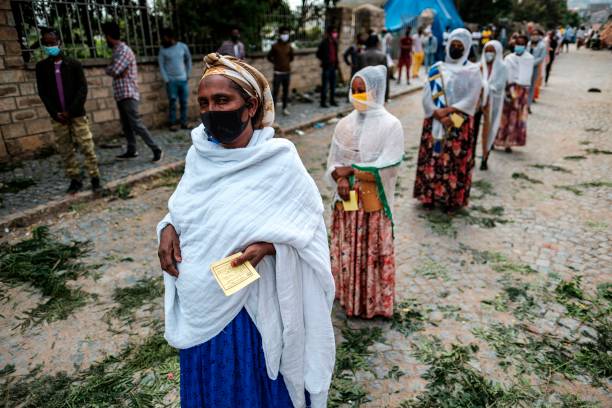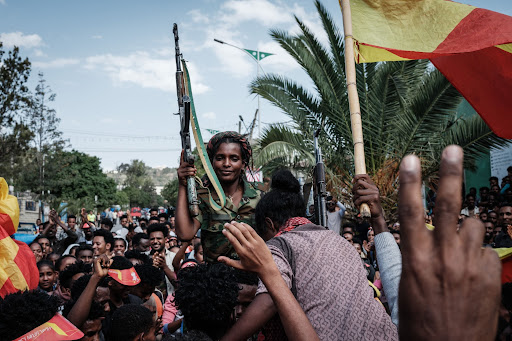Fleeing War – A Personal Experience



When Ethiopian Prime Minister Abiy Ahmed declared war on Tigray in November 2020, the people and government of Tigray were caught by surprise. The unexpectedly gruesome war turned their lives into hell on earth in a matter of weeks.
The government of Tigray had been at odds with the Ethiopian federal government as early as 2018, and ethnically targeted measures against Tigrayans were underway far before the start of the war. However, no one could have predicted that the very government meant to protect the national security of the country and the safety of its people would instead launch such a brutal and barbaric war against its people with assistance from a foreign country.
As if the weaponry and human resources of the Ethiopian National Defense Force (ENDF) would not suffice in their war on the people of Tigray, the ENDF had to form a genocidal alliance with the Eritrean Defence forces (EDF) and Amhara regional special forces. Their task was total destruction: to kill as many Tigrayans as possible and loot and destroy Tigray’s public and private properties in a short period of time. Thus, a great number of troops encircled Tigray supported by helicopter gunships, artillery, and aerial bombardments. Within a few days, they created an inferno and killed tens of thousands of innocent civilians. To make matters worse, the war was declared exactly at the time of harvest when farmers were preparing to earn the results of their hard work throughout the farming season.
The whole of Tigray was being suffocated under a telecommunication blackout and encircled by invading forces partaking in wholescale destruction. The Tigray government, mainly represented by the TPLF, was aware of the impending threat against Tigray. The government tried to prepare itself as much as it could to defend against any potential threat. However, the power imbalance and lack of time for adequate preparation left the Tigrayan government and Tigrayan special forces with no option but to retreat outside of the capital city, Mekelle, in a bid to save as many of its members as possible. In their retreat, the Tigray forces reorganized themselves to combat the invading genocidal forces effectively.
The Emergence of the Tigray Defence Forces (TDF)
As the genocidal intentions of the invading forces became evident in the widespread destruction and massacres committed against Tigrayan civilians, the Tigray Defense Force emerged (TDF) as an army of the people. In addition to Tigray’s trained forces, all who were able to join did — from high school to college students, professors, business owners, and survivors of the violence — as they were left with no other choice. They had to defend their people and region from the indiscriminate killings and criminal intentions of ethnic cleansing by the Abiy Ethiopian regime, Amhara expansionists, and Eritrea’s dictator Isaias Afwerki.
Tigrayan youth have been vital to the ultimate strength and fortitude of the TDF. They joined the TDF in droves, understanding the dire situation Tigray and its people faced. Though no one was spared from the brutal killings unleashed by the invading forces, the youth were their key targets in an effort to undermine and eliminate resistance. Had it not been for the youth’s swift understanding of this threat, as well as the knowledge of experienced senior Tigrayan fighters who had been generals in the ENDF and TPLF, the region would have been left without a valiant resistance to the genocidal forces.
At the time of its establishment, the TDF possessed only rifles, rocket-propelled grenades, and the like. They had no mechanized units, missiles, artillery, or rockets, as United Arab Emirates drones destroyed all heavy machinery they had captured from the northern command in the early days of the war. Despite such early losses, the TDF was able to regroup, driven by the morale of the fighters and the unwavering support of the people of Tigray. The people’s main worry was losing the chance of tilling the farmlands, so they requested that the TDF aim to finish the war in Tigray by June. The people have been doing everything they can to support the fight for the survival of Tigray. A vast majority of Tigrayans inside and outside the country have joined the fight, making the struggle a popular resistance against all aggressors.
The pace of the TDF’s recovery, its restructuring, and its capacity to hit back against multiple enemies of formidable size and weapon arsenal was mind boggling, incredibly heroic, but also demonstrated a great deal of military discipline compared to their Prisoners of War (POWs) and their opposition.
TDF’s Continued Fight to Push out Ethiopian, Eritrean, and Amhara Forces from Tigray
Within weeks, the TDF drove out the ENDF, EDF, and Amhara special forces and militia from most of Tigray, including the entire Southern region of Tigray annexed by Amhara expansionists at the beginning of the genocidal war. However, much of Western Tigray is still under the control of Amhara forces supported by Ethiopian and Eritrean forces.
The TDF has not stopped at its southern borders. It has continued to chase the ENDF and Amhara militia further into the Amhara and Afar regions. Although Abiy’s government declared a unilateral ceasefire, allegedly on humanitarian grounds and to help Tigrayan farmers till their land during the rainy seasons, the TDF and the government of Tigray recognized the ceasefire for what it was—a change in tactics as they were losing the war on the ground.
The same Ethiopian government that destroyed Tigrayan farmers’ fields right before harvest, killed or looted their oxen essential for land tilling and cultivation, and prohibited them from cultivating their fields did not call for a ceasefire for the sake of the farmers. Stating as much is laughable and disrespectful towards the people of Tigray. Thus, to secure a future for their people, the TDF has taken the war beyond Tigray’s borders.
Abiy’s “Ceasefire” to Buy Time for Another Offensive
Certainly, Abiy’s declaration of a ceasefire with a distorted message of humanitarian concern, despite the actual defeat of his forces, was not intended to alleviate the suffering in Tigray. Nor did the prime minister aim to convince the international community, as they certainly have their own means of verifying the facts. The ceasefire was a message directed to his base mainly in Addis Ababa and his supporters in the diaspora, who are fuelled by his divisive and inflammatory propaganda. In their eyes, Abiy is the savior, the messiah, who can transform Ethiopia and bring about prosperity, had it not been for the permanent disturbances the TPLF created to hinder his good intentions.
There was plenty of evidence to suggest that Abiy’s declaration of a ceasefire was just that, a declaration, words. As he pretended to care about the humanitarian crisis, he made sure to seal all supply lines towards Tigray, freeze all bank activities, and shut down power and telecom lines. In other words, he just changed his strategy of genocide from a military offensive targetting civilians on the ground in massacres and other violent crimes to a silent and even more gruesome style of genocide inflicting a slow and painful death on Tigrayans through starvation. Had he been given any breathing room, he would have reorganized his forces and returned to continue his military-led wholesale destruction, but this time with more vigour and cruelty in response to his humiliating defeat.
The TDF and its leaders were aware of Abiy’s fallacious actions and his hidden intentions. Thus, they rejected his fake ceasefire outright and put forth their own terms for a mutual ceasefire. Their terms were simple: restore basic services that have been shut off since the start of the war, stop the mass arrest and ethnic profiling of Tigrayans, and retreat from Tigrayan lands. However, since there was no clear and direct response to their ceasefire proposal, the TDF has continued its offensive against the ENDF and Amhara forces, thereby making substantial progress in diminishing their combat capacity.
TDF’s Discipline
Of all the progress the TDF has made, most remarkable are the TDF’s ethics, discipline, humanity, and fighting spirit. Considering the vast majority of the fighters have lost family members during this war and that some have witnessed their family and friends being executed or brutally sexually assaulted, the way the TDF treats POWs is admirable.
The TDF’s wartime ethics and morality was exhibited when they captured towns in the Amhara and Afar regions. They made it clear to local residents that they do not harbor any resentments and thus would not interfere in their day-to-day lives. The only thing civilians had to do was keep the peace, stay safe, and leave their arms at home.
In contrast to all members of the genocidal coalition, who looted, killed, and raped in Tigray, the TDF has proven to be highly ethical and disciplined, thus successfully mobilizing the people peacefully inside and outside their regional territory.
Given the drastic imbalance in the number of fighters and forces the TDF has been up against, the consecutive military victories the TDF has scored is a remarkable accomplishment short of a miracle that could have historic implications for the Ethiopian state and the wider Horn of Africa.
The essence of the TDF‘s victories and its ethical code is grounded in its mission of fighting for the people. TDF fighters are left with no choice but to fight for their survival and that of their people. How long the fight will take is yet to be determined, but in the end, there is no doubt that the popular resistance of the people of Tigray led by the TDF will prevail.
Aman – Omna Tigray Contributor, August 2021